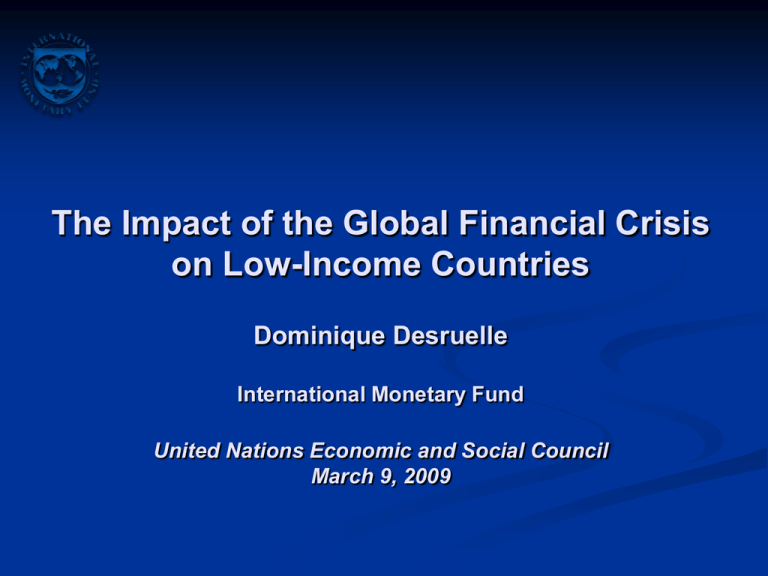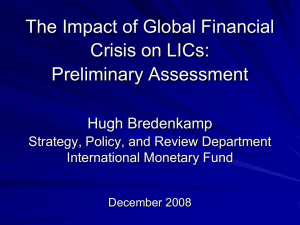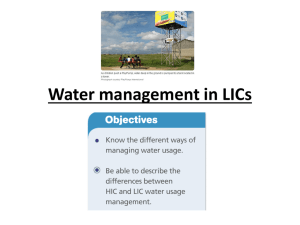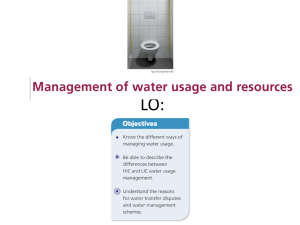Mr. Dominique Desruelle, Advisor, Strategy and Policy Review Department, International Monetary Fund
advertisement

The Impact of the Global Financial Crisis on Low-Income Countries Dominique Desruelle International Monetary Fund United Nations Economic and Social Council March 9, 2009 Key messages The third wave of the global crisis is hitting low-income countries (LICs) LICs are more integrated than before: trade, foreign direct investment, and remittances 22 LICs face acute financial constraints in 2009: additional financing needs of at least US$25 billion The donor community must act to provide scope for countercyclical policies Background: A decade of progress in LICs Better policies, global growth, and debt relief resulted in: 10.0 60 Debt-to-GDP (in percent, right axis) 9.0 Remittances, FDI, and Exports in percent of GDP Real GDP growth (in percent, left axis) 40 50 8.0 6.0 35 1990 2000 2007 30 25 International reserves in months of imports (left axis) 7.0 More exports More foreign direct investment More remittances Higher growth Higher reserves Lower debt 40 20 15 5.0 30 4.0 10 5 0 3.0 20 1997 2002 2007 Remittances/GDP FDI/GDP Exports/GDP The global environment is drastically worsening Net food and fuel importers were weakened by the 200708 price shock 450 Selected Commodity Prices 400 (January 2004=100) 350 300 250 Metals Energy 200 Commodities exporters now face increased pressure on external accounts 150 100 Food 50 Jan-04 Jan-05 Jan-06 Jan-07 Jan-08 Jan-09 Jan-10 Dec-10 Dec-10 Source: IMF staff projections. Abrupt slowdown in advanced and emerging partner countries 2009 global outlook Lower GDP growth 18 16 14 12 10 8 6 4 2 0 12 10 8 GDP growth (percent) WEO Spring 2008 Latest projections 6 4 2 0 All LICs SubSaharan Africa Asia Higher current account deficits Middle Latin East and America Europe Current account deficit (in percent of GDP) All LICs SubSaharan Africa Asia WEO Spring 2008 Latest projections Middle Latin East and America Europe Immediate contagion from direct financial channels limited so far, but risks exist… Reduced inflows into domestic markets Hardened terms on foreign borrowing Reduced availability of trade credit Rollover risk (sovereign and private debt) Banking system Parent banks restricting financing Second-round effects: Impact of lower growth on the quality of banks’ credit portfolio Main transmission channels: Trade, remittances, fdi 110 105 LIC Exports (G&S) index (2007=100) LIC Rem ittances index (2007=100) 120 Pre-shock (Spring 2008 WEO) 100 115 95 110 90 105 85 Post-shock (Current projection) Pre-shock (Spring 2008 WEO) Post-shock (Current projection) 100 80 95 2007 2008 2009 2007 Sources: WEO Database; and Fund staff calculations 2008 2009 So urces: WEO database; and Fund staff calculatio ns. LIC FDI index (2007=100) 140 Pre-shock (Spring 2008 WEO) 130 120 110 100 Post-shock (Current projection) 90 80 2007 2008 2009 So urces: WEO database; and Fund staff calculatio ns. External crisis is rapidly spilling over into a budgetary crisis… Drop in revenues—esp. for commodity exporters Commodity Revenues to Total Revenue, 2008 (Ratio, in percent of total revenue) Increased spending pressures, including to protect the poor Tighter financing conditions (domestic, external) Congo, Republic of Chad Nigeria Angola Yemen, Republic Azerbaijan Sudan Papua New Guinea Mauritania Mongolia Guinea Vietnam 0 Source: IMF staff estimates. 20 40 60 80 100 …Affecting debt sustainability Debt indicators are projected to continue improving but less than before Moreover, new risks have emerged Exchange rate depreciation Support to banking sector Higher borrowing to offset the impact of the crisis could pose serious risks IMF Policy Recommendations Fiscal stimulus: Monetary and exchange rate policies: Some LICs with strong fiscal positions have space to expand Most LICs face binding financing constraints: need higher aid to help avoid procyclical policies LICs with falling inflation may have room for monetary easing Allow exchange rate to absorb shocks Closely monitor financial sector risks 22 countries face acute financing needs And financing needs could rise well above $25 billion if downsize risks materialize… Billions of U.S. dollars Baseline Downside Risk Scenario Number of Countries 250 100 200 80 150 60 100 40 50 20 0 0 BOP Shock (all affected LICs) Financing need of LICs with acute financing gap Sources: WEO database, and Fund staff calculations Number of LICs with acute financing gap (right side) The IMF is responding to its members’ needs Financial assistance to LICs increased substantially in 2008 New or scaled-up loan agreements with several LICs are expected to be in place soon We are stepping up provision of non-financial support (policy advice, technical assistance) 2007 2008 6 5 4 3 2 1 0 30 25 20 15 10 5 0 Total amount disbursed New financing Augmentations of agreements (number access under existing of countries, right side) arrangements (number of countries, right side) Key messages The third wave of the global crisis is hitting low-income countries (LICs) LICs are more integrated than before: trade, foreign direct investment, and remittances 22 LICs face acute financial constraints in 2009: additional financing needs of at least US$25 billion The donor community must act to provide scope for countercyclical policies Thank you





